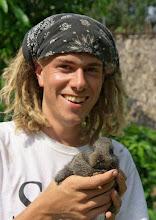"The most important thing for a farmer is, you have to love trees." [1]
Most of us don't think of trees when we think of farms, but here in Sahelian Africa, where I'll be living until July, trees are vital to life.
There are few trees left.
 |
| A baobab watches the Sahara desert blow by in the wind. |
The baobab (Adansonia digitata) is a highly revered tree[3]: the bark is harvested repeatedly for fiber, the fruit is delicious, and the leaves are a nutritious vegetable. Added to this, the trunk isn't fleshy, so cutting it down for lumber wouldn't work anyway.
The kad (Faidherbia albida) is so useful that the Sereer have integrated this tree into their agro-pastoral systems for centuries. While most trees leaf out in the rainy season and loose their leaves in the dry season, this tree does just the opposite! That makes it an ideal companion tree to millet fields and cow pastures. In the rainy season, when crops can utilise all the sun they can get, the tree looses its leaves, fertilising the crops below. In the long dry season, new leaves and nutritious seed pods appear, providing shade for the maturing crop below and a source of fodder for the cattle herders. Over the centuries, Sereer farmers would carefully manage this tree, nurturing new seedlings that sprouted in their fields, and maintaining them through careful pruning. Since the 1970's, however, social shifts have all but ended this practice; today, almost all of the remaining kad trees are adults, and their numbers are slowly diminishing.
 |
| Kad trees (and a baobab, 2nd from the left). Note the heavy pruning for cattle forage. |
Perhaps the landscape has failed the farmers. Perhaps the farmers have failed the landscape. In any case, there are fewer and fewer trees, more and more dust, and less and less harvest.
What am I doing in Senegal? Well, this week I'm picking up a chainsaw and cutting some wood to make charcoal. And thoroughly enjoying it. But more on that next week.[5]
 |
| A Sereer family's dwelling |
[1] Opening statement by the Senegalese founder of a local agriculture training school, when introducing his school and philosophy to us. He couldn't have endeared himself to us any faster.
[2] Four, if you include villages and towns: mango and neem trees have been widely planted around habitations.
[3] I mean this in a literal sense as well as a figurative one. I don't yet fully understand the full dynamics of Sereer relationships with Baobab as a whole, but they fear the evil spirits that inhabit one of the trees I camped under last week so much that they wouldn't get near it after dark.
[4] This would have been my estimate, but here's a source (pdf) that substantiates that number.
[5] Inshallah!

